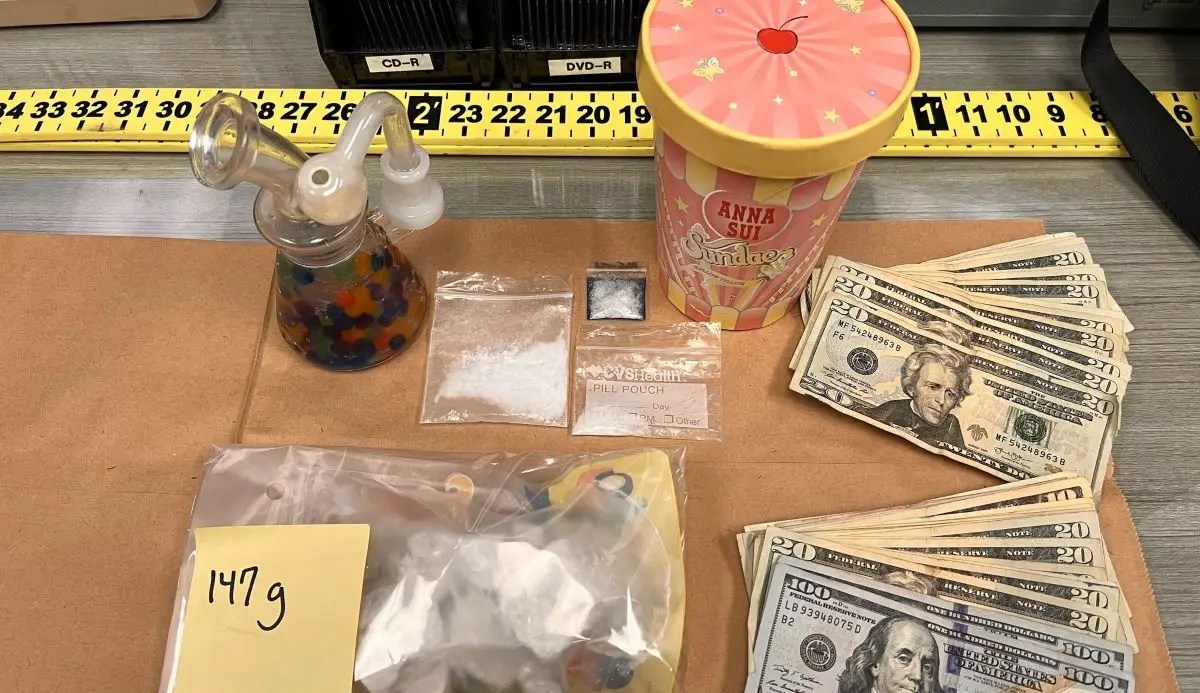
This post was originally published on this site
On Sunday, police officers responded to a call for service at a local hotel, regarding a suspicious vehicle in the parking lot, according to the Placentia Police Department.
The police officers conducted a thorough investigation and discovered two subjects involved in drug sales and transportation.
The officers recovered a large sum of cash, approximately 147 grams of Fentanyl and 6 grams of Methamphetamine.
Both subjects were arrested and booked at Orange County Jail.
Considering its deadly nature and the quantity, 147 grams of fentanyl represents a very significant seizure, likely valued at a minimum of tens of thousands of dollars, and potentially well into the hundreds of thousands or more if broken down into individual street-level doses.
In California, a gram of meth can reportedly range from $10 to $100, or even up to $400 depending on purity and specific location. For 6 grams, this would put the retail value in the range of $60 to $2,400. More commonly, in Southern California, it’s often cited as $20-$40 per gram. So, $120 to $240 would be a more typical estimate for 6 grams at a street-level retail price.
Potential Penalties for Drug Trafficking/Possession with Intent to Sell in California
The charges would primarily fall under California Health and Safety Code sections related to drug offenses. Given the quantities, possession for sale and potentially transportation or sale charges would be the most relevant.
Key Charges and Penalties:
1. Possession for Sale of Fentanyl (Health & Safety Code 11351 H&S – Controlled Substances):
- Felony Offense: This is a serious felony.
- Prison Time: If convicted, the penalty is 2, 3, or 4 years in state prison.
- Fines: Up to $20,000.
- Drug Testing & Supervision: Likely extensive probation or parole upon release, with mandatory drug testing.
2. Possession for Sale of Methamphetamine (Health & Safety Code 11378 H&S – Methamphetamine):
- Felony Offense: This is also a felony.
- Prison Time: If convicted, the penalty is 16 months, 2 years, or 3 years in state prison.
- Fines: Up to $10,000.
3. Enhancements Based on Quantity (Health & Safety Code 11370.4 H&S and 11370.74 H&S for Fentanyl):
California law imposes significant sentencing enhancements based on the weight or quantity of certain controlled substances. This is where the 147 grams of Fentanyl becomes extremely critical.
- For Fentanyl (H&S 11370.4):
- Over 20 grams: An additional 3 years.
- Over 40 grams: An additional 5 years.
- Over 80 grams: An additional 10 years.
- Over 120 grams: An additional 15 years.
- Over 1 kilogram: An additional 20 years.
- Over 10 kilograms: An additional 25 years.
- Given 147 grams of Fentanyl, the enhancement would be an additional 15 years in state prison (for exceeding 120 grams). This is added on top of the base sentence for possession for sale.
- For Methamphetamine: While 6 grams of Methamphetamine is not a huge quantity for a weight enhancement, it does contribute to the overall seriousness. Enhancements for Methamphetamine typically begin at 4 kilograms (H&S 11370.4), so it would not trigger a weight enhancement in this specific case, but it’s still a separate felony charge.
4. Concurrent vs. Consecutive Sentences:
- The court will determine if the sentences for the Fentanyl and Methamphetamine charges run concurrently (at the same time) or consecutively (one after the other). Given the different types of drugs and the significant quantity of Fentanyl, consecutive sentencing is a possibility, especially with the Fentanyl enhancement.
5. Other Potential Factors and Consequences:
- Prior Criminal Record: A prior felony conviction, especially for drug-related offenses, would significantly increase penalties and could result in “strikes” under California’s Three Strikes Law, leading to double the sentence or 25 years to life in prison for a third strike.
- Criminal Street Gang Enhancement: If the individual is a documented gang member and the crime was committed for the benefit of a criminal street gang, severe additional prison time could be added (Penal Code 186.22 PC).
- Asset Forfeiture: Law enforcement can seize cash, vehicles, and other property believed to be proceeds from drug trafficking.
- Immigration Consequences: For non-U.S. citizens, drug trafficking convictions can lead to deportation.
- Parole/Probation: Upon release from prison, the individual would likely be subject to strict parole or post-release community supervision.
- Mandatory Minimums: Some drug offenses carry mandatory minimum sentences, meaning the judge has less discretion to reduce the sentence below a certain threshold.
Example Calculation (Illustrative – NOT a definitive prediction):
Let’s assume a conviction for both charges and the fentanyl enhancement, with no prior criminal record or gang enhancement:
- Base sentence for Possession for Sale of Fentanyl: 3 years state prison (mid-term)
- Enhancement for Fentanyl quantity (over 120g): +15 years state prison
- Base sentence for Possession for Sale of Methamphetamine: 2 years state prison (mid-term)
If the sentences are run consecutively for the base and enhancement, the potential total state prison sentence could be 20 years (3 + 15 + 2). If the methamphetamine sentence runs concurrently, it could be 18 years.
In summary, an arrest involving 147 grams of Fentanyl for sale in California, even with a smaller amount of Methamphetamine, is an extremely serious felony carrying the potential for a lengthy state prison sentence, likely well over a decade, due to mandatory quantity enhancements for Fentanyl.

